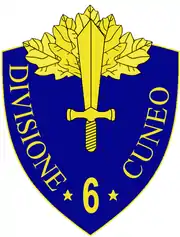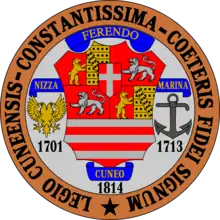6th Infantry Division Cuneo
The 6th Infantry Division Cuneo was an infantry division of the Italian Army during World War II. The Division was formed on 24 May 1939 in Milan, largely from the parts of 58th Infantry Division Legnano. The Cuneo Division was part of the III Corps, First Army that took part in the Italian invasion of France and the 26th Corps during Greco-Italian War.
| 6th Infantry Division Cuneo | |
|---|---|
 6th Infantry Division Cuneo Insignia | |
| Active | 1939–1943 |
| Country | Italy |
| Branch | Italian Army |
| Type | Infantry |
| Size | Division |
| Nickname(s) | Cuneo |
| Engagements | World War II |
| Commanders | |
| Notable commanders | Carlo Melotti[1] |
| Insignia | |
| Identification symbol |  |
| Identification symbol | Cuneo Division collar insignia |
Action
During the Italian invasion of France, the Cuneo division was assigned to the Limone Piemonte area 10 June 1940, advancing to Tende by 21 June 1940, but the armistice of 24 June 1940 happened before the division could take any action. After the fall of Himarë to Greece on 22 December 1940, the Cuneo division was tasked to re-capture the town. For this purpose, it landed in Vlorë on 28 December 1940, but failed to reach the assault positions.[2] The Cuneo division fought a defensive battle at LLogara pass from 29 December 1940 until 31 January 1941, in appalling conditions of mountain winter,[3] with resulting frequent deaths due exposure. The units of the Cuneo division were dispersed in February, 1941 among others, participating in combat from Vuno to Berat. On 29 March 1941 the Cuneo division was withdrawn from the front line to the west bank of Drin river in Albania, to counter the threat of the Yugoslavian army after the pro-axis coup in Yugoslavia has collapsed. The Cuneo division reinforced the gap in between the 41st Infantry Division Firenze and the 9th Corps in defensive lines at the Yugoslav border.[4] After Germany entered the war against Greece on 6 April 1940, the Cuneo Division moved to its original positions and started an offense toward Himarë on 14 April 1941. The Greek defence line collapsed on 16 April 1941. On 17 April 1941, the Cuneo Division advanced through Himarë and Porto Palermo. On 19 April 1941 the Cuneo Division had captured a Piqueras village in Lukovë municipality, then Sarandë town by combined land and amphibious assault, and captured the southernmost Albanian town of Konispol on 23 April 1941. The Cuneo Division remained in Greece as an occupying force, first in Igoumenitsa and Paramythia, later in Missolonghi and finally on Cyclades - garrisoning the islands of Naxos and Icaria (by garrison and coastal batteries), Samos (division headquarters), Andros, Santorini and Syros (garrison only),[5] until the Italian surrender on 8 September 1943.[6] It held off the German counter-attack until 21 November 1943, but was evacuated to Kuşadası in Turkey after the positions had become untenable. At the end of war, the remnants of Cuneo Division were interned by the Allies in Bureij, Gaza Strip.
The names of three Italian men attached to the Cuneo Division can be found in the CROWCASS list established by the Anglo-American Allies of the individuals wanted by Greece for war crimes.[7]
Order of battle

Notes
- Footnotes
- An Italian Infantry Division normally consisted of two Infantry Regiments (three Battalions each), an Artillery Regiment, a Mortar Battalion (two companies), an Anti Tank Company, a Blackshirt Legion (Regiment of two Battalions). Each Division had only about 7,000 men, The Infantry and Artillery Regiments contained 1,650 men, the Blackshirt Legion 1,200, each company 150 men.[8]
- Citations
- Mulholland, John. "Axis Order of Battle 10 June 1940 - The Italian Invasion of France". Axis History. Retrieved 13 April 2009.
- John Carr,"The Defence and Fall of Greece 1940-1941", p. 120.
- John Carr,"The Defence and Fall of Greece 1940-1941", p. 95
- John Carr,"The Defence and Fall of Greece 1940-1941", p. 198
- http://www.wwii-photos-maps.com/italianarmy/Order%20of%20Battle/slides/Italian%20Army%20OB%20%20070.html
- Wendal, Marcus. "Italian Army". Axis History. Retrieved 13 April 2009.
- (Name) Antimanto Vittorio; (C.R. File Number) 300006; (Rank, Occupation, Unit, Place and Date of Crime) Lt. of Res., 7 Inf.Regt. "Cuneo"-Div., Serifos (Grc.) 11.41 - 9.43; (Reason wanted) Misc. Crimes; (Wanted by) Grc.; LENTI Nicholas - 300295 - Major and Governor, Inf., 7 Italian Regt. "Cuneo"-Div. Military of Naxos during the Italian Occ., Island of Naxos 41-43 - Misc. Crimes - Grc.. In: The Central Registry of War Criminals and Security Suspects, Consolidated Wanted Lists, Part 2 - Non-Germans only (March 1947), Uckfield 2005 (Naval & University Press, facsimile edition of the original document), pp. 57, 65; BELANI Peter - 304292 - Pvt., Art. Cuneo Div. from Milan (It.), Minia Platanou (Samos) (Grc.), 6.4.43 - Murder - Grc.. In: Ibid., Supplementary Wanted List No. 2, Part 2 - Non Germans (September 1947), p. 81
- Paoletti, p 170
- Paoletti, Ciro (2008). A Military History of Italy. Greenwood Publishing Group. ISBN 0-275-98505-9.